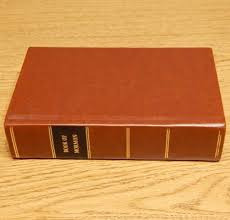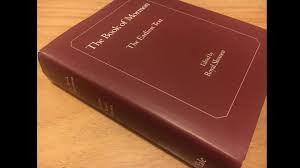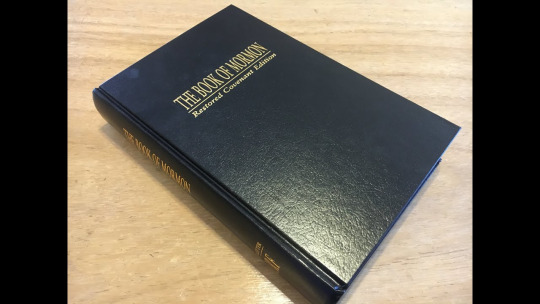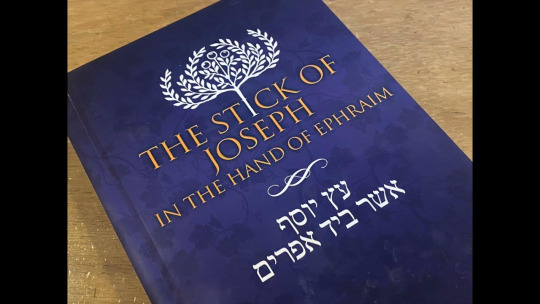A non-Mormon's look at the fascinating world of Mormonism
Don't wanna be here? Send us removal request.
Text
I wrote this post in 2018 on my Corybanter blog. I thought it would fit here on Mormonophile quite nicely. (In fact, I think it's the first time I ever used the word "Mormonophile."
0 notes
Text
Different editions of The BoM...how different are they?
So if I'm counting correctly, I have about 56 different copies of The Book of Mormon in my personal library. This includes a few foreign language editions (in Russian and Spanish). Most of them are just different formatting of the commonly available editions published by The Church of Jesus Christ of Latter-day Saints. Some are individual copies of The Book of Mormon, while others are part of "triple combo" or "quad combo' editions. If you're a non-Mormon, those terms may not mean a lot to you. They're nicknames for publications that combine the BoM with other LDS/Mormon scriptures, such as The Doctrine & Covenants, The Pearl of Great Price, and the King James Bible. Other editions of the 1920, 1981, or 2013 versions of the LDS text are annotated editions edited by various people. That accounts for most of my collection
However...some of the versions in my library are quite different from the usual LDS editions. I thought I'd take some time to address some of the more interesting non-LDS versions of the BoM in my collection. So here we go...forgive me if I come off as a total geek.

Facsimile Editions
Since the BoM, having been originally published in 1830, has long been in the public domain, several publishers have created facsimile editions that try to re-create the BoM in a similar format to how it first appeared. I have three different facsimile editions from different publishers, and I find them quite enjoyable to read sometimes. Joseph Smith originally published the BoM without chapter and verse numbering, in a single column format. So even though the titles of the various books (1 Nephi, 2 Nephi, etc.) are pretty much the same as modern editions, the text in each book is divided into paragraphs that read more like a novel than a Bible. Each of the facsimiles is a bit different the others: one has blue speckling on the sides of the pages, the thickness of each is a bit different, and the quality of the typeface is a bit different in each. (Also, two of the editions retain certain printing errors, such as the misspelling of the word "seen" in the Testimony of the Three Witnesses.)

Royal Skousen's The Earliest Text
There is probably no greater expert in the printing history of the BoM than LDS scholar Royal Skousen. In 2009 he published The Book of Mormon: The Earliest Text, which was an attempt to reconstruct the text of the BoM in its earliest form, before it was actually published. This task was much harder than it may seem at first. The BoM as originally published was based on a handwritten manuscript (in English) with no punctuation or capitalization, only about 28% of which still survives. After the book was first published in 1830, Smith made hundreds of corrections to the original publication, and the Church has made numerous corrections and changes since then. Much more detail is given in the Introduction to the book, written by LDS scholar Grant Hardy. You can read the entire first edition for free online at Book of Mormon Central. Skousen released an updated Second Edition in 2022, with a brand new Introduction by himself, that is well worth reading for its insights into his process.

The Restored Covenant Edition
Several years ago, I stumbled over a leather-bound copy of the BoM at my local used bookstore, entitled The Book of Mormon: Restored Covenant Edition. It was clearly not published by the LDS Church, but it was beautifully laid out The Title Page included this interesting claim:
With text restored to its purity from the Original and Printer's Manuscripts as translated by the gift and power of God through Joseph Smith, Jr. from the original plates preserved by the hand of God to come forth for this time.
I found that intriguing, and added the edition to my collection. I later found out that the edition was published by the Zarahemla Research Foundation, and mostly edited by an RLDS scholar named Shirley Heater. For formatting of the text, this edition may be the most enjoyable one to read. A second edition of this version was recently published, only in softcover.

The Stick of Joseph in the Hands of Ephraim
Perhaps the most unusual version of the BoM in my collection is this publication, entitled The Stick of Joseph in the Hands of Ephraim. Of course, the different title catches the eye immediately, but it gets even more interesting from there. Much like some "Hebrew names" editions of the Bible, that use Hebrew names in the Old and New Testaments (Moshe, Chava, Yeshua, etc.), this edition replaces Nephi with Nefi, Moroni with M'roni, Jacob with Ya'akov, and so forth. No longer is the "translator" called Joseph Smith, Jr., but the much more Hebrew sounding "Yosef Ben Yosef." "The Lord" is replaced by "YHWH," to indicate where the Tetragrammaton (The Name of God) would likely have been found if the text were originally written in Hebrew (which, to my knowledge, no Mormon scholars had ever claimed).
It is an unusual publication, to be sure. However, if you really want to view the BoM as a literary creation of ancient Hebrews, rather than the creation of a 19th century American farmer, the way the text is handled in this edition is pretty evocative. As a non-Mormon, of course, I don't have any strong position on the origins of the book, so I'l let the reader decide whether this approach is valid or not.
So those are some of the more interesting non-LDS versions of The Book of Mormon in my collection. I will address some other versions as the blog continues. It may go without saying that, for most people, it's probably considerably easier just to get a free paperback BoM from LDS missionaries than it is to get a hold of one of the versions described above. But if you become interested in digging deeper into the text, as I have, you might find one of these publications to be useful or interesting. Thanks for checking into the Mormonophile blog!
0 notes
Text
Welcome to Mormonophile!

Allow me to introduce myself: although I am not a member of The Church of Jesus Christ of Latter-day Saints, I have long been fascinated by Mormon culture and history, particularly the enigmatic work of literature which is The Book of Mormon. I have a fairly extensive library of various editions of The Book of Mormon, including some of the official publications of the LDS Church, as well as quite a few other editions that are not published by the Church. So yes, I am a “Mormonophile” (one who is fascinated by Mormonism).
My own faith tradition is rooted quite firmly in the mainline Christian tradition: I was raised Lutheran, I rediscovered my faith as an adult in the Episcopal Church, my wife and I attended a couple of churches in the Disciples of Christ denomination, and for the past 17 years I have directed music at United Methodist churches. While I am interested in Mormonism as a topic of study, I am not interested at all in actually becoming a Latter-day Saint. I have had many enjoyable interactions with LDS people, and count some of them among my friends.
I believe my first encounter with The Book of Mormon was when I was a child; I’m not sure why, but my mother had a 1970s paperback copy of The Book of Mormon on the shelf, but I don’t think she had ever read it. I have a copy much like it in my collection now, and it looks like this:

I think I browsed through it a few times as a child, but I don’t remember being extremely interested in it. I did think it looked a bit like the Bible, but the names of the books (Nephi, Mosiah, Alma, etc.) were completely unfamiliar to me.
When I was in college, my girlfriend briefly flirted with the idea of converting to Mormonism, after a positive encounter at her LDS roommate’s church. At that time, I researched the faith a bit at my college’s library, and found most of what I read pretty confusing. She didn’t convert, though, and I pretty much forgot about Mormonism for several years.
I don’t recall when exactly I began getting interested in reading and collecting The Book of Mormon, but I think it was sometime after I got married. My wife had a hardback copy that she had ordered from the LDS Church, but she was not at all impressed. I think I encountered a large-print hardback edition at a used book sale while I was in grad school. It looked a little something like this:

After that, I gradually began to grow my collection of various Book of Mormon editions that I encountered from time to time, and I even began to read it.
At first, I found the narrative quite confusing. The style, which certainly seemed to consciously mimic the style and cadence of the King James Bible, was unusual, to say the least. And the endless repetitions of “And it came to pass…” were jarring and not a little amusing. Eventually, I think I must have Googled “book of mormon online” or something, because I ended up finding a website called bookofmormon.online, a site created by an active member of the LDS Church that I found immensely helpful. I still use that site fairly regularly, and over the years I have become friends with the site’s creator, KC Kern. (More stories about that site, as well as my friendship with KC, to come in future posts.)
That’s a fairly short version of how I became a Mormonophile. If this blog continues, I will go into more detail about my collection of Mormon literature, as well as some of my encounters with LDS people over the years. (All of those encounters have been positive, and I continue to have a special place in my heart for the Saints.) I also intend to share some of my thoughts about The Book of Mormon and its fascinating history.
Thanks for reading!
0 notes